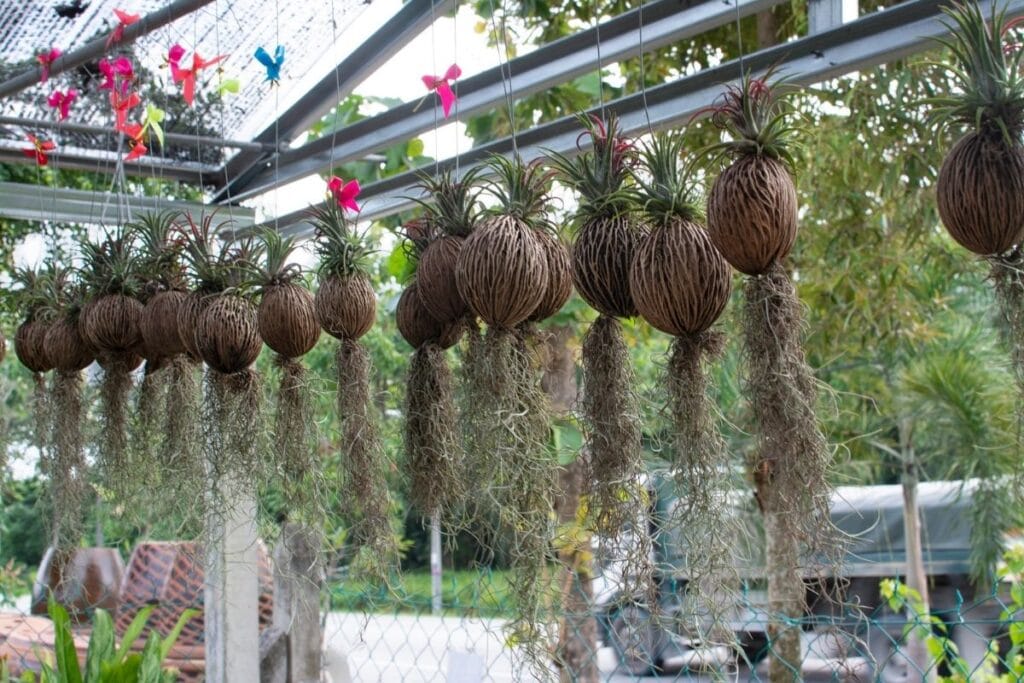Air plants of the Tillandsia genus make some of the most fascinating and unique house plants of all. There are over 600 different species in the genus, and a large number of them are available everywhere from department stores to specialized nurseries all over the world.
With such a bewildering range of species, however, picking the perfect Tillandsia for your home can be intimidating. This article showcases 9 of the best options available for your home.
As evergreen perennial flowering plants, here are some varieties of tillandsias you can grow indoors:
Tillandsia ionantha
This species, which is commonly known as the sky plant, is probably the most popular of the Tillandsias. This is often what people new to air plants acquire. It forms clumps that are striking, and easy to grow. In time with its tubular purple flower bloom, the leaves also blush to red.
Sky plants grow to a size of about 12 inches (30 cm) and are available in many interesting cultivars. These hardy plants are great for beginners because they are easy to maintain indoors.
Tillandsia duratii
Tillandsia duratii is a species that grows wild in Argentina, Bolivia, and Paraguay. This silver-green plant grows to a height of over 2 feet (0.6m), including the flower spike.
This species easily adapts to different types of climates, making it one of the most successful air plants. The root system is barely present but the curly leaves make up for it by clinging on to surfaces. The flowers are lavender-like and are very fragrant.
Tillandsia usneoides
Also known as the Spanish moss, this air plant deviates from the usual upright and strong appearance of most tillandsias. It appears as long curly hair, silvery green in color. It has a strong dramatic effect left hanging in baskets or draped on tree branches.
This species does flower, although the blossoms are not as showy as in other Tillandsia species. There are several cultivars available that differ mainly in leaf size and shape.
Tillandsia harrisii
Tillandsia harrisii is another great air plant for beginners. It is a relatively large species that can grow to about 8 inches (20cm) tall. It does not need a particularly humid environment to thrive.
This hardy air plant has thick soft leaves that are velvety to the touch. It bears pinkish-red inflorescence and long purple flowers.
Tillandsia pseudobaileyi
The graceful leaves of this air plant look like twigs covered in snow as they appear silvery being densely covered with trichomes. The foliage is relatively narrow, and attractively twisted. This species is also characterized by maroon-purple lines that run the length of the stiff leaves.
Tillandsia cyanea
Tillandsia cyanea has the distinction among air plants of being one of the few species that are able to grow on soil. It can be grown in a pot or even be used as a groundcover in partly shaded gardens. In the middle of long green leaves emerge long-lasting bright pink and blue flowers looking like a quill, hence the common name ‘Pink Quill’.
Tillandsia rothii
This Mexican species is one of the more drought tolerant air plants. It can be grown in full sun but will reach heights of up to 18 inches (0.45m) even in shade. Its pale green flower blooms atop the red, green, and yellow mass of bracts.
Tillandsia tectorum
Tillandsia tectorum is one of the most popular air plants among collectors and is suitable even for beginners. This air plant has thin but strong leaves covered in fluffy trichomes.
The leaves can reach up to a foot (0.3m) long in some specimens, while others will mature at just a few inches. The silver color of this striking plant shines in the morning and in the night and is accentuated by the purple and violet flowers emerging from the pink bracts.
Tillandsia xerographica
This xeric species grows in semi-arid habitats in nature, making it a hardy air plant in drier homes. It is a large and striking species with relatively broad silvery leaves.
T. xerographica can get by with less water than other air plants, but it does enjoy plenty of light. Direct morning sunlight will benefit this plant. The leaves of this species tend to curl up when dry, which is attractive and not unhealthy for the plant.
Conclusion
The diversity of the Tillandsia genus makes these plants a joy to collect and grow. Even though only a fraction of air plant types are introduced in this article, you can’t help but marvel at the beauty of these fascinating epiphytes. Be sure to check out our Tillandsia care guide if you’re interested in growing your own air plants.
Up next: How to care for air plants
*image by sweemingyoung/depositphotos







